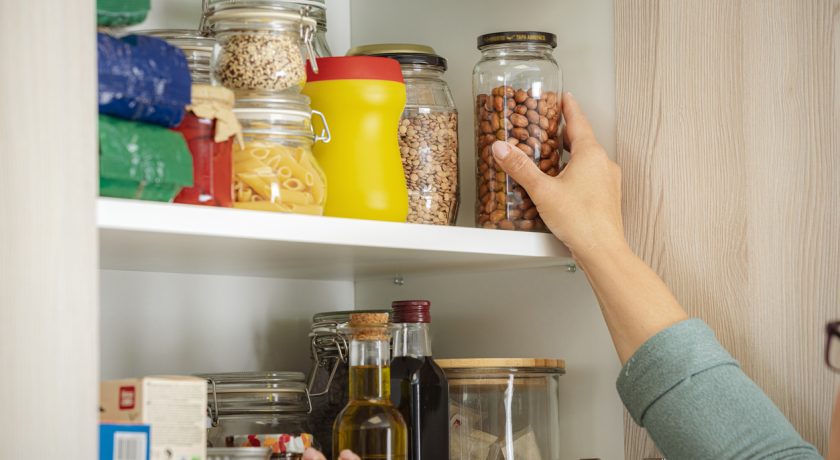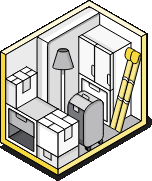Organize Your Small Food Pantry Efficiently

A small pantry can often become cluttered and overwhelming when searching for items. Whether you have a pantry closet or shallow shelves in your kitchen, organizing your food and beverages can help maximize your pantry space and keep your pantry items easily accessible.
We at XYZ Storage understand your struggle, which is why we’ve created a guide to share storage solutions to help you create a more functional small pantry setup and to organize your kitchen. From maximizing vertical space to ensuring your pantry shelves stay organized, you’ll learn a few tricks to turn your dedicated pantry in your kitchen into a well-organized space. In other words, you’ll make mealtime preparation go by much smoother.
How to Organize a Small Food Pantry in 8 Easy Steps
Here are eight steps to help you get started in creating your dream food pantry, while keeping it organized.
Step 1: Empty and Clean Your Pantry
Before you start your pantry organization, it’s important to begin by emptying all of your pantry items from your small pantry. This includes any pasta, rice, baking ingredients, snacks, and any other food items you keep in your pantry. By doing this, it will give you a clean slate and allow you to properly see how much space you have in your pantry, including shelf space. Plus, while you’re emptying your pantry this allows you to check for expired goods.
Once you finish emptying your pantry, you can now give it a good clean. Take a damp cloth and mild detergent to wipe down your pantry shelves to remove any dust and crumbs left behind. You can also sweep the floor space to remove any lingering debris. If your pantry closet has deep shelving, consider installing shelf liners to keep surfaces clean and prevent items from slipping.
Step 2: Sort and Categorize Pantry Items
Now that you have a freshly cleaned small pantry, you can begin organizing your items. One way to approach organizing your pantry is by categorizing your pantry items into categories so it’s easier to find what you’re looking for. Here are some example categories:
- Baking essentials – Flour, sugar, baking soda, and vanilla extract
- Canned goods – Vegetables, beans, soups, and sauces
- Grains and pasta – Rice, quinoa, lentils, and pasta varieties
- Healthy foods – Nuts, dried fruit, protein bars, and whole grains
- Kids snack section – Granola bars, fruit pouches, crackers, and popcorn
- Breakfast staples – Cereal, oats, pancake mix, and syrup
- Condiments and sauces – Oils, vinegar, ketchup, mustard, and soy sauce
- Spices and seasonings – Salt, pepper, herbs, and spice blends
- Snacks and treats – Chips, cookies, chocolates, and candy
Step 3: Maximize Vertical Space
One of the best ways to store items in a small pantry is to use the vertical space. Here are some ideas for making the most of the vertical space in your pantry:
- Install additional shelving: instead of relying solely on pantry shelves already built in your small pantry, you can add floating shelves or tiered racks to help make use of the vertical space.
- Use stackable and clear containers: purchase clear and stackable containers to effectively arrange your pantry items.
- Under-shelf baskets – Hanging baskets attached to the bottom of pantry shelves can store lightweight items like napkins, plastic bags, or snack pouches.
- Use risers for cans and jars – Tiered risers help keep them visible and accessible, preventing them from getting lost in the back of deep pantry shelving.
Step 4: Use Clear Storage Containers
Clear containers are a game-changer when it comes to pantry organization. Transfer all of your food items to storage containers, specifically dry goods so you can keep them fresh in airtight containers. Here are other benefits to using clear storage units when organizing your pantry:
- Keeps food fresh for a long time
- Prevents spills and messes
- Allows you to quickly see what needs to be restocked
For example, storing flour, sugar, and rice in large, clear bins with secure lids can prevent pest issues while keeping your pantry space organized. You can even include labels on these containers with expiration dates ensuring you use older products first.
Step 5: Optimize Pantry Shelving and Floor Space
Does your small pantry include floor space? If so, you’re in luck! Instead of letting the floor space in your pantry go to waste, consider using rolling carts, pull-out baskets, and tiered storage racks to add more storage to your pantry. By incorporating these storage solutions you can make meal prep easier, reduce food waste, and make items easier to find. No matter what type of storage solution you use to help optimize your pantry shelving and floor space a little creativity can go a long way.
Step 6: Make Use of Pantry Doors
Next, make use of your pantry door! Your pantry door is an additional space you can take advantage of using over-the-door organizers or hooks for storing more of your lighter items, such as spices, smaller kitchen tools, and snacks. However, if you don’t need to use your door for extra space, consider hanging a dry-erase board or chalkboard to jot down your grocery list or your daily meals for the week. For households with a busy schedule, having a schedule placed in the pantry can be helpful.
Step 7: Label Everything
Adding labels to all your items in your small pantry can be especially helpful. This includes labeling baskets, containers, and even pantry shelves to ensure everything gets placed back to its designated spot after use. Having labels ensures that everyone in your household knows what and where everything is, which can be useful in a big or chaotic household. You can use chalkboard labels, sticker labels, or even printed labels to add a more clean look.
Step 8: Regular Maintenance and Restocking
Maintaining an organized small pantry is an ongoing process that doesn’t just stop after completing steps one through seven. Every so often depending on your household needs you can take the time to:
- Discard expired or stale pantry items
- Wipe down pantry shelves and bins
- Adjust shelf space as needed
- Do a quick inventory check if you are out of stock of an item before you do a grocery run
By completing the above you’ll ensure that your pantry organization is kept up to par at all times.
FAQs
What are the best storage solutions for a small food pantry?
The best storage solutions for a small food pantry are tiered shelving, stackable bins, and over-the-door organizers to help you maximize floor space and vertical space. Always go with clear containers whenever possible since it can help make it easier to see what’s inside at a glance. Additionally, using storage baskets for similar group items will make pantry organization a much more efficient process. For example, placing all of your chips in one basket and snack bars in another.
How do I maximize vertical space in a small pantry?
To help you maximize vertical space in your small pantry you can start by installing pantry shelves and stackable and tiered storage organizers.
What items should I prioritize in a small food pantry?
Unfortunately, your pantry isn’t made up of an infinite amount of space (although you probably wish it was at times), which is why it’s important to prioritize the most essential items. For example, grains, canned goods, and any frequently used spices. Any everyday ingredients or items should be within easy reach while storing bulk and seasonal items higher up in your small food pantry.
How can I keep track of expiration dates in a small pantry?
To manage expiration dates efficiently, label all containers and packages with the date they were purchased or the expiration date. Implementing a “first in, first out” system where older items are placed in front and newer ones are stored behind ensures that nothing goes to waste. Clear bins and storage containers also make it easier to monitor food freshness. Doing a quick pantry check before grocery shopping can help prevent expired items from accumulating.
Are clear containers better for organizing a pantry?
Yes, clear containers help reduce clutter, keep food fresh, and allow you to see contents at a glance, making unpacking groceries more efficient. By maintaining a uniform look, they contribute to a clean and visually appealing pantry while making it easier to locate ingredients quickly.
How do I organize canned goods in a small space?
Use tiered can organizers, stackable bins, or lazy Susans to keep canned goods visible and easy to access. For extra efficiency, group canned goods by category, such as soups, vegetables, and proteins, so you can quickly grab what you need when cooking.
What’s the best way to group items in a small food pantry?
Group similar pantry items together by category, such as baking supplies, snacks, grains, and condiments, to make meal prep easier. Consider organizing by category, such as baking supplies, snacks, grains, and condiments. Another helpful method is to use baskets or bins to separate frequently used items from occasional-use products. Labeling each category ensures that everything has a designated spot, making it easier to put groceries away and find what you need.
How often should I clean and reorganize my pantry?
It’s best to clean and reorganize your small pantry every few months to prevent clutter and food waste. Take time to check for expired or stale items, wipe down shelves and containers, and adjust storage solutions based on your changing needs
What are some tips for labeling pantry shelves and containers?
Use clear, consistent labels with bold text to ensure all household members can easily find and return items to their proper place. Consider labeling not just containers, but also pantry shelves, so everyone in the household knows where items belong. This simple step helps maintain order and prevents things from getting misplaced.
How can I prevent clutter in a small pantry?
Regularly decluttering, using stackable storage, and keeping an up-to-date shopping list can help prevent excess items from piling up. By consistently tidying up and reassessing your pantry’s organization, you can maintain a clean and functional space without unnecessary clutter.
How XYZ Storage Can Help
If your small pantry still feels cluttered and overcrowded despite taking the time to maximize your storage space, XYZ Storage has the ideal solution for you. Our self-storage units can help you store away items you don’t use daily. For example, if you have extra kitchenware, utensils, or small appliances you can store them temporarily in one of our affordable storage units. With secure and easily accessible self-storage locations across Toronto and the GTA, including Downtown Toronto, Toronto Midtown, Toronto West, Etobicoke, and Scarborough.
Have questions about what you can store in your storage unit? Stop by any one of our storage facilities and our team of storage experts will be more than happy to assist you. Happy storing!











